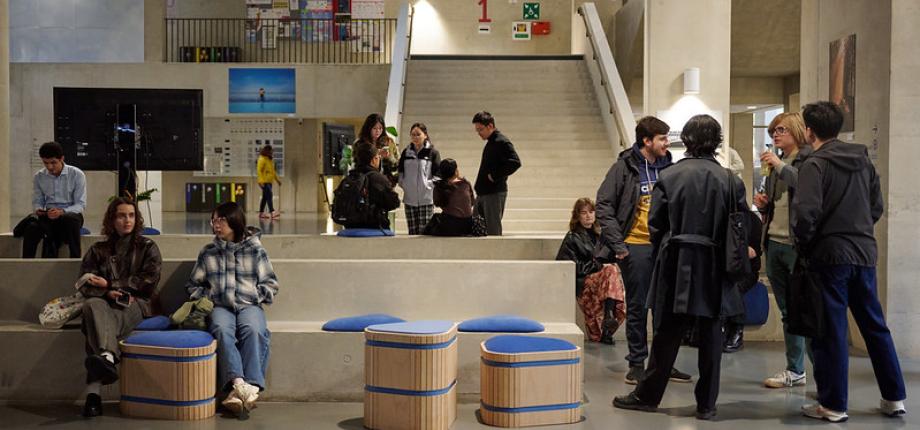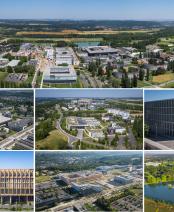Master Year 1 in Civil Engineering and Construction

| Year | Master Year 1 |
| Program | Civil Engineering |
| ECTS Credits | 60 |
| Language | French |
| Orientations | Professional / Industry |
| Location | ENPC, Champs-sur-Marne Campus |
| Course duration | 12 months, full time |
| Course start | September |
| Degree awarded | Master’s degree obtained on completion of the second year of the Master |
WHY ENROLL IN THIS PROGRAM?
Asset n° 1
Benefit from training provided by the École nationale des ponts et chaussées, an institution internationally recognized for the quality of its civil engineering and construction training.
Asset n°2
Benefit from project-based learning and experimentation, with a high level of scientific rigor and strong technical expertise.
Asset n°3
Benefit from the expertise of internationally renowned teachers from both the professional world (providing a strong link to practical experience) and the academic world (providing a strong link to research and innovation).
The civil engineering and construction sector, which has long been the core business of the École nationale des ponts et chaussées, is particularly well represented at the national level. Internationally, demand for equipment, infrastructure, and buildings is driving strong growth in the sector:
- major infrastructure projects,
- maintenance and upkeep of existing equipment,
- energy production and storage,
- building renovation and rehabilitation.
Entire cities in certain emerging countries, offshore constructions, transportation networks... Today, construction around the world is at an unprecedented level. Urban concentrations require the invention of entirely new solutions for buildings and infrastructure (very tall buildings, metropolitan networks, etc.). But in a context of climate emergency, biodiversity loss, and land artificialization, the environmental impact of construction is such that a profound renewal of techniques is necessary to reduce energy consumption, limit greenhouse gas emissions, and recycle materials. Soil erosion, pollution, and instability are becoming increasingly frequent. Addressing these issues requires significant advances in soil mechanics and related techniques. The frequency of extreme events is increasing, requiring more resilient buildings and infrastructure. New materials (very high-strength concrete and steel, composites) and new computer-based calculation methods are emerging, revolutionizing the design of buildings and structures. Digitization and robotization are opening up new prospects for efficient and sustainable construction.
As a result of these various transitions, the relationship between society and technology has changed. Great attention must now be paid to context, environment, and users, requiring engineers to be able to explain, negotiate, and debate in order to arrive at the most appropriate technical solutions. These fundamental changes call for high-level design and construction engineers who are able to tackle the complexity of construction systems using a multidisciplinary approach.
The first year of the program (M1 “Civil Engineering and Construction”) provides all the necessary foundations for civil engineering and construction: scientific (mechanics, physics, thermodynamics, etc.), technical (drawing, materials, etc.) and cultural. The M1 is open to students who have not previously studied civil engineering.
Objectives
- Master the scientific, technical, and cultural foundations of civil engineering and construction.
- Master the fundamentals of project planning and design in the fields of structural engineering and geotechnical engineering, adopting a comprehensive approach, a high level of scientific rigor, and strong technical expertise.
- Understand the challenges (environmental, societal, technical, etc.) involved in the construction process.
The master's program prepares students to work in all sectors of the construction industry (buildings, structures, public works, geotechnics, energy facilities, materials, etc.) and opens the door to a wide range of careers: project management, project supervision, design offices, construction companies, research and development, methods.
Graduates go on to work in:
- the design and construction of structures, infrastructure, and buildings,
- the calculation and dimensioning of structures,
- the innovation and development of new materials and new construction techniques,
- the management of large construction projects
| Course title | ECTS / Language |
| Introduction to drawing and modeling | 1 / French |
| Introduction to Construction Materials | 1 / French |
| “Construction and Living” Week | 1 / French |
| Built Structures: From Design to Completion | 3 / French |
| Introduction to Drawing and Modeling | 3 / French |
| Digital Statistics and Data Analysis | 1,5 / French |
| Mathematics and Mechanics for Civil Engineering | 4 / French |
| Soil Mechanics | 3 / French |
| Elastic Structure Mechanics | 3 / French |
| Fluid Mechanics | 3 / French |
| Material Calculation and Behavior | 3 / French |
| Thermal Engineering | 1,5 / French |
| Languages | 2 / French |
| Course title | ECTS / Language |
| Engineering Geology Week | 0,5 / French |
| Mathematics and Mechanics for Civil Engineering | 5,5 / French |
| Mechanics of Elastic Structures 2 | 1,5 / French |
| Plasticity and Failure Analysis | 3 / French |
| Structural Dynamics | 3 / French |
| Practical Machine Learning | 3 / French |
| Structural Design Theory | 3 / French |
| Geotechnical Design Theory | 3 / French |
| Design Applied to Structures or Geotechnical Works | 5,5 / French |
| Languages | 2 / French |
Admission requirements
Academic prerequisites
- Bachelor's degree in science (physics, mechanics, mathematics, engineering sciences, etc.),
- Bachelor's degree in civil engineering, or CPES (preparatory classes for engineering schools).
Language prerequisites
- French (required level: B1 for students of Latin languages, B2 for students from other countries)
How to apply
Applications can be submitted exclusively online. You will need to provide the following documents:
- Diplomas and transcripts (from high school to most recent grades)
- Ranking certificates (if available)
- Two academic references (added online directly by your referees)
- CV/resume
- Statement of purpose
- Copy of ID
Fees and scholarships
Registration fees are available here
Find out more about scholarships
Please note that fees and scholarships may change for the following year.
Applications and admission dates
The civil engineering and construction sector, which has long been the core business of the École nationale des ponts et chaussées, is particularly well represented at the national level. Internationally, demand for equipment, infrastructure, and buildings is driving strong growth in the sector:
- major infrastructure projects,
- maintenance and upkeep of existing equipment,
- energy production and storage,
- building renovation and rehabilitation.
Entire cities in certain emerging countries, offshore constructions, transportation networks... Today, construction around the world is at an unprecedented level. Urban concentrations require the invention of entirely new solutions for buildings and infrastructure (very tall buildings, metropolitan networks, etc.). But in a context of climate emergency, biodiversity loss, and land artificialization, the environmental impact of construction is such that a profound renewal of techniques is necessary to reduce energy consumption, limit greenhouse gas emissions, and recycle materials. Soil erosion, pollution, and instability are becoming increasingly frequent. Addressing these issues requires significant advances in soil mechanics and related techniques. The frequency of extreme events is increasing, requiring more resilient buildings and infrastructure. New materials (very high-strength concrete and steel, composites) and new computer-based calculation methods are emerging, revolutionizing the design of buildings and structures. Digitization and robotization are opening up new prospects for efficient and sustainable construction.
As a result of these various transitions, the relationship between society and technology has changed. Great attention must now be paid to context, environment, and users, requiring engineers to be able to explain, negotiate, and debate in order to arrive at the most appropriate technical solutions. These fundamental changes call for high-level design and construction engineers who are able to tackle the complexity of construction systems using a multidisciplinary approach.
The first year of the program (M1 “Civil Engineering and Construction”) provides all the necessary foundations for civil engineering and construction: scientific (mechanics, physics, thermodynamics, etc.), technical (drawing, materials, etc.) and cultural. The M1 is open to students who have not previously studied civil engineering.
Objectives
- Master the scientific, technical, and cultural foundations of civil engineering and construction.
- Master the fundamentals of project planning and design in the fields of structural engineering and geotechnical engineering, adopting a comprehensive approach, a high level of scientific rigor, and strong technical expertise.
- Understand the challenges (environmental, societal, technical, etc.) involved in the construction process.
The master's program prepares students to work in all sectors of the construction industry (buildings, structures, public works, geotechnics, energy facilities, materials, etc.) and opens the door to a wide range of careers: project management, project supervision, design offices, construction companies, research and development, methods.
Graduates go on to work in:
- the design and construction of structures, infrastructure, and buildings,
- the calculation and dimensioning of structures,
- the innovation and development of new materials and new construction techniques,
- the management of large construction projects
| Course title | ECTS / Language |
| Introduction to drawing and modeling | 1 / French |
| Introduction to Construction Materials | 1 / French |
| “Construction and Living” Week | 1 / French |
| Built Structures: From Design to Completion | 3 / French |
| Introduction to Drawing and Modeling | 3 / French |
| Digital Statistics and Data Analysis | 1,5 / French |
| Mathematics and Mechanics for Civil Engineering | 4 / French |
| Soil Mechanics | 3 / French |
| Elastic Structure Mechanics | 3 / French |
| Fluid Mechanics | 3 / French |
| Material Calculation and Behavior | 3 / French |
| Thermal Engineering | 1,5 / French |
| Languages | 2 / French |
| Course title | ECTS / Language |
| Engineering Geology Week | 0,5 / French |
| Mathematics and Mechanics for Civil Engineering | 5,5 / French |
| Mechanics of Elastic Structures 2 | 1,5 / French |
| Plasticity and Failure Analysis | 3 / French |
| Structural Dynamics | 3 / French |
| Practical Machine Learning | 3 / French |
| Structural Design Theory | 3 / French |
| Geotechnical Design Theory | 3 / French |
| Design Applied to Structures or Geotechnical Works | 5,5 / French |
| Languages | 2 / French |
Admission requirements
Academic prerequisites
- Bachelor's degree in science (physics, mechanics, mathematics, engineering sciences, etc.),
- Bachelor's degree in civil engineering, or CPES (preparatory classes for engineering schools).
Language prerequisites
- French (required level: B1 for students of Latin languages, B2 for students from other countries)
How to apply
Applications can be submitted exclusively online. You will need to provide the following documents:
- Diplomas and transcripts (from high school to most recent grades)
- Ranking certificates (if available)
- Two academic references (added online directly by your referees)
- CV/resume
- Statement of purpose
- Copy of ID
Fees and scholarships
Registration fees are available here
Find out more about scholarships
Please note that fees and scholarships may change for the following year.














